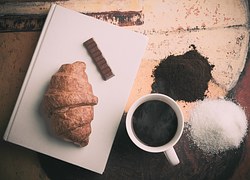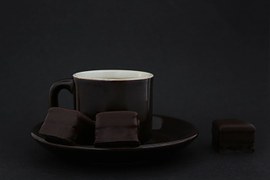
Wine and chocolate… two of my favorite things. What could possibly go wrong?
It turns out, quite a lot.
While both wine and chocolate are popular date night treats (or, if you’re like me, every night treats), many chocolate geeks agree that you’ll enjoy chocolate more if you skip the wine (interestingly, sommeliers do not appear to feel the same way about avoiding chocolate while drinking wine… but this is a chocolate blog, so let’s focus on how wine affects the taste of chocolate for now).
I should clarify that when I say you shouldn’t drink wine while eating chocolate, I don’t mean chocolate cake, or chocolate mousse, or even chocolate truffles. Baked items and many filled chocolate confections contain ingredients (butter, cream, liquid sugars) that will counteract many of the issues I describe below. I’m only suggesting you avoid one thing: drinking a big ol’ glass of wine while nibbling a bar of solid chocolate.
Here you go: 3 reasons to avoid pairing wine and chocolate
Reason #1: Sugar rivalry
Let’s start with the most straight forward reason wine and chocolate don’t make great bedfellows: they’re too competitive. Specifically, they both want to control your sweetness-detecting taste buds. When consuming chocolate and wine together, whichever one is sweeter will increase your perception of bitter flavors in the other. Usually (but not always), the sweeter one in such a pairing will be the chocolate. The sugar in chocolate may overwhelm the subtle fruity and floral notes detectable in many wines. And if you’re drinking a sweet or off-dry wine, you may lose a lot of the delicate raisin and berry flavors that are often prominent in very dark chocolate. In either case, you’re going to have a less than ideal tasting experience.
Reason #2: Some like it hot
Cocoa butter is a fussy, complicated, high-maintenance fat in many ways — and cocoa beans contain about 50% cocoa butter by weight. One of cocoa butter’s characteristic traits is its sensitivity to very small changes in ambient temperature. Solid at room temperature, cocoa butter softens steadily in warmer temperatures, beginning to melt in the high 80’s.
Knowing this, chocolate makers refine cocoa beans and sugar so the cocoa butter crystals and sugar particles in chocolate are the perfect size to melt and release their flavor in the average 97-98 degree mouth. Chocolate makers know that if the particle size is too small, the chocolate will taste slimy or waxy. Too big, and it’s grainy or gritty. To avoid these flaws, particle size is calibrated with incredibly precision, and with the assumption that the chocolate will be served at room temperature, and eaten by someone with a — I know this sounds funny — warm mouth.
With that in mind, let’s think about how drinking wine might affect these assumptions. Red wine is typically served between 50 – 65 degrees, and white wine is usually served colder than that. For several minutes after drinking a cool beverage, the temperature of the inside of your mouth decreases dramatically. If your mouth is cool and you try to eat chocolate, the result will be… yuck. I find most chocolate tastes waxy and flavorless if I’ve just had something cold to drink.
Slightly off topic, but this should also explain why chocolate should be brought to room temperature before you eat it (if it was stored in the fridge). And it’s also why chocolate chunks should be banned from ice cream recipes (my personal pet peeve… although even I have to admit that Häagen-Dazs Chocolate Chocolate Chip is the best thing ever invented by human kind. But I digress).
Reason #3: Opposites attract
Both red wine and dark chocolate pair best with foods that balance their most pronounced flavors rather than compete with them. For example, the fattiness and blandness of cheese really complements the bright acidity of wine. In contrast, orange juice, which is acidic like wine, would be a terrible palette cleanser at a wine tasting. Can you imagine?
Wine — particularly red wine — shares many flavor components with dark chocolate, including acidity and astringency. The flavonoids (including tannins) that give structure to red wine also produce the astringency (that dry tongue feeling) and characteristic reddish-brown color of chocolate. The astringent quality of both wine and chocolate is more pronounced in an acidic environment (such as your mouth right after gobbling chocolate or chugging wine), so pairing them together will highlight the astringent notes in both, resulting in a less-than-ideal tasting experience.

I hope none of this information discourages you from consuming wine and chocolate separately (or, screw it, even together — there is no reason to be puritanical about it). But if you’re enjoying chocolate at home or with friends, might I suggest you try something like this instead:



I found your post very enlightening. There’s been a lot of hype lately about chocolate & wine pairings. I’ve always enjoyed them separately, but thought maybe I was missing out on something. Any thoughts on chocolate & beer pairings?
LikeLiked by 1 person
I’ve heard really good things about chocolate and beer pairings actually. I think you would still have the temperature issue, but I’m not sure how you get around that if you’re eating chocolate while drinking a cold beverage. Maybe you could eat the chocolate first, then sip the beer? Or have some warm food to nibble on in between tastings?
LikeLike
A chocolate blog! How fun. I write a wine blog. And I must tell you I’m not a big fan of the whole chocolate and wine thing. Having said that, as you point out it can work (particularly with baked goods). And the best chocolate and wine pairing I’ve had with solid chocolate have been chocolates made specifically for a wine. That tells me some thought (and I bet experimentation) had gone into it and it’s not just a matter of picking up a Hershey bar and deciding it will go well with the glass of Merlot in you hand. I do find that as long as the wine is sweeter than the chocolate you have a good chance for success (I’m fond of 75-85% Cacao bars with a Port for example). Any way. You’ve made some great point, and your post was a great read! Thank you!
LikeLiked by 1 person
Love your blog! I can imagine chocolate and wine might work together under very specific circumstances — like what you described here with a bitter dark chocolate and Port. Especially if the chocolate is eaten first, so the sweetness of the Port doesn’t overpower it.
LikeLike